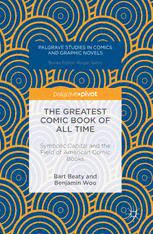
The Greatest Comic Book of All Time: Symbolic Capital and the Field of American Comic Books PDF
Preview The Greatest Comic Book of All Time: Symbolic Capital and the Field of American Comic Books
PALGRAVE STUDIES IN COMICS AND GRAPHIC NOVELS Series Editor: Roger Sabin THE GREATEST COMIC BOOK OF ALL TIME Symbolic Capital and the Field of American Comic Books Bart Beaty and Benjamin Woo Palgrave Studies in Comics and Graphic Novels Series Editor Roger Sabin University of the Arts London London , United Kingdom This series concerns Comics Studies – with a capital “c” and a capital “s”. It feels good to write it that way. From emerging as a fringe interest within Literature and Media/Cultural Studies departments, to becoming a minor fi eld, to maturing into the fastest growing fi eld in the Humanities, to becoming a nascent d iscipline, the journey has been a hard but spec- tacular one. Those capital letters have been earned. Palgrave Studies in Comics and Graphic Novels covers all aspects of the comic strip, comic book and graphic novel, explored through clear and informative texts offering expansive coverage and theoretical sophistica- tion. It is international in scope and provides a space in which scholars from all backgrounds can present new thinking about politics, history, aesthetics, production, distribution, and reception, as well as the digi- tal realm. Books appear in one of two forms: traditional monographs of 60-90,000 words and shorter works, part of Palgrave Pivot, of 20-50,000 words. All are rigorously peer-reviewed. Palgrave Pivots include new takes on theory, concise histories, and – not least – considered provocations. After all, Comics Studies may have come a long way, but it can’t progress without a little prodding. Series Editor Roger Sabin is Professor of Popular Culture at the University of the Arts London, UK. His books include Adult Comics: An Introduction, and Comics, Comix and Graphic Novels, and his recent research into 19th century comics is award-winning. He serves on the boards of the main academic journals in the fi eld, and reviews graphic novels for the international media. Also in the series: Documentary Comics: Graphic Truth-telling in a Skeptical Age by Nina Mickwitz The Greatest Comic Book of All Time: Symbolic Capital and the Field of American Comic Books by Bart Beaty and Benjamin Woo More information about this series at http://www.springer.com/series/14643 Bart Beaty • B enjamin Woo The Greatest Comic Book of All Time Symbolic Capital and the Field of American Comic Books Bart Beaty Benjamin Woo University of Calgary Carleton University Calgary, Alberta, Canada Ottawa, Ontario, Canada Palgrave Studies in Comics and Graphic Novels ISBN 978-1-137-56196-1 ISBN 978-1-137-53162-9 (eBook) DOI 10.1057/978-1-137-53162-9 Library of Congress Control Number: 2016936506 © The Editor(s) (if applicable) and The Author(s) 2 016 This work is subject to copyright. All rights are solely and exclusively licensed by the Publisher, whether the whole or part of the material is concerned, specifi cally the rights of translation, reprinting, reuse of illustrations, recitation, broadcasting, reproduction on microfi lms or in any other physical way, and transmission or information storage and retrieval, electronic adaptation, computer software, or by similar or dissimilar methodology now known or hereafter developed. The use of general descriptive names, registered names, trademarks, service marks, etc. in this publication does not imply, even in the absence of a specifi c statement, that such names are exempt from the relevant protective laws and regulations and therefore free for general use. The publisher, the authors and the editors are safe to assume that the advice and information in this book are believed to be true and accurate at the date of publication. Neither the pub- lisher nor the authors or the editors give a warranty, express or implied, with respect to the material contained herein or for any errors or omissions that may have been made. Printed on acid-free paper This Palgrave Macmillan imprint is published by Springer Nature The registered company is Nature America Inc. New York A CKNOWLEDGMENTS We began work on this project during the 2013–2014 academic year when Benjamin Woo was a postdoctoral fellow in the Department of English at the University of Calgary. During that time, we co-taught a graduate sem- inar on “the comics canon” that led us to consider the various ways that comics studies has been shaped by ideological and methodological assump- tions that remain unstated. We are thankful to the students involved in that seminar (Garrett Beatty, Samantha Massey, Tom Miller, Liam Nolan, and Eli Wilkinson) for their insights during the early stages of this project. We would also like to thank the Social Sciences and Humanities Research Council for funding the postdoctoral fellowship that initiated this project, as well as the Insight Grant that supported its completion. v C ONTENTS 1 What If the Greatest Comic Book of All Time Were… 1 2 Maus by Art Spiegelman? 1 7 3 A Short Story by Robert Crumb? 2 7 4 A Superhero Story by Jack Kirby? 43 5 Written by Alan Moore? 53 6 The Cage by Martin Vaughn-James 65 7 By Rob Liefeld? 73 8 An Archie Comic? 8 5 9 Not by a White Man? 9 7 vii viii CONTENTS 10 Persepolis by Marjane Satrapi? 109 11 Dave Sim’s Cerebus? 121 12 Hicksville by Dylan Horrocks? 1 33 Index 1 43 L F IST OF IGURES Fig. 1.1 Visualizing the comics canon 8 Fig. 1.2 The structure of fi elds of cultural production 1 2 Fig. 8.1 Comic book sales, 1960–1970 8 7 Fig. 8.2 Archie Comics sales, 2007–2013 8 9 ix
